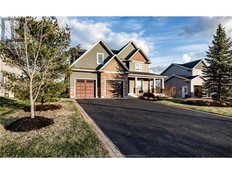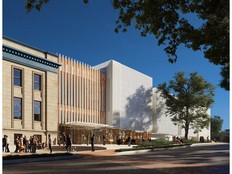David Campbell: We need community immigration plans
New Brunswick’s population increased by 80,000 between July 2018 and April 2024

Article content
We are living in an unprecedented time. You might scoff at that assertion but in at least one important way it is true. Statistics Canada is reporting New Brunswick’s population increased by 80,000 between July 2018 and April 2024. This is truly an unprecedented level of population growth over a six-year time frame no matter how you look at it.
In absolute terms, the population rose from 770,000 to 850,000. In percentage terms, it is up more than 10 per cent. We added more than the entire population of Saint John in just six years.
To put this in perspective, the last time New Brunswick had a mini population boom was in the early 1970s. Between 1970 and 1976, the province added just 61,500 to its population.
Even more amazing, between 1976 and 2017, the population of New Brunswick increased by only 77,000. You read that correctly. In the past six years, we have added more to the population than the 41 years between 1976 and 2017.
Much, but not all, of this growth has come from immigrants, international students and temporary workers. They are playing a vital role across the province meeting workforce needs, helping ensure local K-12 schools do not close and supporting broader community development. As one example this is not just a Moncton phenomenon, The City of Edmundston had a faster immigration rate than Montréal.
It is likely the annual growth rate of newcomers will slow in the coming years, but attracting population to communities large and small will be important if we want to prosper as a province.
To ensure all regions of New Brunswick benefit, I am convinced now more than ever we need community level immigration and population growth plans. These plans should address three main themes: 1) community buy-in; 2) workforce development; and 3) integration.
I was disappointed to read that city council in Bathurst voted down a project to renovate a long-vacant building to create housing for students of the Collège communautaire du Nouveau-Brunswick. I have said in this column multiple times that the community college system should be deliberately used as conduit for newcomer attraction. While in school, they study, work, get to know the community and even put up with a couple of our long winters. They should be much more likely to stay long term if they studied here first.
Think about this statistic. Twenty years ago, there were 125 people under the age of 15 living in Gloucester County in northeastern New Brunswick for every 100 aged 65 and older. In other words, assuming young people stayed, there were enough young people to replace older residents as they left the workforce through retirement.
Now there are only 36 under the age of 15 for every 100 aged 65 and older. There are few jurisdictions in all of North America that have seen such a radical shift in demographics. The Bathurst region will need to attract hundreds of young families in the coming years just to ensure enough workers to meet basic workforce needs.
We need to talk about this with local residents. It does not matter if it is Bathurst, Edmundston or Woodstock, we need to have a serious conversation about the future. What kind of community do we want to leave for future generations? Of course, we need to have answers to all the questions being asked. There are a lot of unfortunate things being said about newcomers, but it is important we start from the position that everyone with questions about immigration is not a racist.
Secondly, our community immigration plans should focus on bringing in immigrants to participate across our economy and society. I am convinced of this more than ever.
We should avoid bringing in immigrants solely to meet a single industry’s need such as fish plant workers, foresters or truck drivers. Our health care workforce should be increasingly diverse even as the population grows more diverse. Our children should be taught by a diverse mix of teachers including those who were born in other countries. We are seeing immigrants working in all sectors of the economy in places like Moncton and Fredericton and we should be deliberate about this in communities across the province.
The third theme of our community immigration plans, and possibly the most complicated, is that we should strive to avoid segregation of newcomers. In many communities across Canada with a longer history of immigration, it is common to have churches or mosques that cater to a single ethnic group. There are neighbourhood schools almost entirely populated with the children of recent immigrants. There are employers that hire predominantly immigrants and others who hire very few. Even many personal and professional services firms are targeting specific ethnic groups.
Many newcomers prefer to worship in their own language, work in a business with others from their country of origin, socialize with other newcomers and live in neighbourhoods alongside others with a similar background. There must be a balance between ethnocultural community development and integration into the wider community.
I recently interviewed a number of immigrant families in a mid-sized Ontario city, many who had lived there for decades, and they told me of their continued struggles to fit into the community. They felt many jobs were still off limits to them. Certain social and professional networks were out of reach. In many cases they did not know the non-immigrant families that lived on their street.
I am not suggesting we should purposely avoid ethnocultural community association. Having clusters of ethnic populations has been shown to help foster longer term retention. But we should be more deliberate in our efforts to ensure newcomers feel they are part of the wider community in which they live. They should know their neighbours. They should feel able to worship in the same places. They should be able to join the same social circles.
Using good public policies and community practices, we should encourage multicultural schools, workplaces and other gathering places. Our professional and social networks should embrace newcomers.
In urban centres such as Bathurst, Edmundston and Miramichi and even smaller places like Sussex, Caraquet and Saint Andrews, we have the opportunity to learn from other communities across the country. We can put in place the best examples of immigrant attraction and retention from across the country and beyond.
If we can put community immigration plans in place that focus on public support for population growth, encourage newcomers to work in all sectors, and foster true integration of newcomers into our society, we should be able to attract enough population in the coming years to support strong local economies and ensure we have enough tax revenue to sustainably fund public services.
David Campbell is president of Jupia Consultants Inc., an economic development consulting firm based in Moncton, and New Brunswick’s former chief economist












Postmedia is committed to maintaining a lively but civil forum for discussion. Please keep comments relevant and respectful. Comments may take up to an hour to appear on the site. You will receive an email if there is a reply to your comment, an update to a thread you follow or if a user you follow comments. Visit our Community Guidelines for more information.